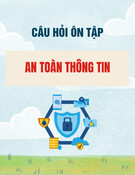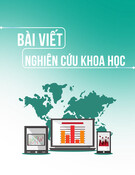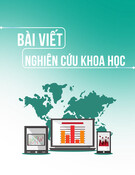
94
Số 15 (12/2024): 94 – 102
A REVIEW OF DEEP LEARNING-BASED ALGORITHMS FOR OBJECT
DETECTION IN SATELLITE IMAGES
Nguyễn Trung Hiếu1*
1Khoa Toán – Tin học và Ứng dụng Khoa học và Công nghệ trong Phòng chống tội phạm,
Học viện Cảnh sát Nhân dân
* Email: hieunt.dcn@gmail.com
Ngày nhận bài: 03/10/2024
Ngày nhận bài sửa sau phản biện: 09/12/2024
Ngày chấp nhận đăng: 15/12/2024
ABSTRACT
Object detection in satellite images is a particularly interesting area in computer vision.
This paper synthesizes and analyzes the challenges and characteristics of satellite images, as
well as existing methods, with a special emphasis on the role of deep learning. The authors point
out that object detection in satellite images is different from that in conventional images due to
the high resolution, noise, and diversity of objects. To address these challenges, this paper
introduces anchor-based and non-anchor-based methods in detail, and highlights the advantages
and disadvantages of each method. In particular, the emergence of Transformer architectures in
computer vision has opened up a new promising direction for object detection in satellite
images. In addition, this paper also discusses practical applications of object detection in satellite
images, including environmental monitoring, resource management, and disaster response.
Finally, the paper suggests potential future research directions, such as developing more
efficient models, handling small objects, and leveraging diverse data sources.
Keywords: computer vision, deep learning, object detection, satellite imagery.
NGHIÊN CỨU CÁC THUẬT TOÁN HỌC SÂU TRONG PHÁT HIỆN
ĐỐI TƯỢNG TRÊN ẢNH VỆ TINH
TÓM TẮT
Vấn đề phát hiện đối tượng trong ảnh vệ tinh đang là một lĩnh vực được quan tâm đặc
biệt trong thị giác máy tính. Bài báo này tổng hợp và phân tích các thách thức, đặc điểm của
ảnh vệ tinh, cũng như các phương pháp hiện có, đặc biệt nhấn mạnh vai trò của học sâu. Các
tác giả đã chỉ ra rằng, phát hiện đối tượng trong ảnh vệ tinh khác biệt so với hình ảnh thông
thường do độ phân giải cao, nhiễu và sự đa dạng của các đối tượng. Để giải quyết những thách
thức này, bài báo đã giới thiệu chi tiết các phương pháp dựa trên anchor và không dựa trên
anchor, đồng thời làm rõ ưu nhược điểm của từng phương pháp. Đặc biệt, sự nổi lên của kiến
trúc Transformer trong lĩnh vực thị giác máy tính đã mở ra một hướng đi mới đầy hứa hẹn
cho việc phát hiện đối tượng trong ảnh vệ tinh. Ngoài ra, bài báo cũng đề cập đến các ứng
dụng thực tế của việc phát hiện đối tượng trong ảnh vệ tinh, bao gồm giám sát môi trường,
quản lý tài nguyên và ứng phó với thảm họa. Cuối cùng, bài báo đã đưa ra những hướng
nghiên cứu tiềm năng trong tương lai, như phát triển các mô hình hiệu quả hơn, xử lý các đối
tượng nhỏ và tận dụng các nguồn dữ liệu đa dạng.
Từ khóa: ảnh vệ tinh, học sâu, phát hiện đối tượng, thị giác máy tính.

Số 15 (12/2024): 94 – 102
95
KHOA HỌC KĨ THUẬT VÀ CÔNG NGHỆ
1. INTRODUCTION
In recent years, the application of artificial
intelligence in various fields has brought about
significant breakthroughs. In particular,
computer vision, with its ability to analyze and
understand images, has become an effective
tool in many practical applications. One of the
core research problems of computer vision is
object detection, and among them, object
detection in satellite images is attracting
increasing attention.
Satellite images provide a huge source of
data about the Earth, with increasingly high
resolution and detail. However, extracting
useful information from these images
requires complex algorithms and models (Li
et al., 2019). Object detection in satellite
images is a difficult problem, requiring
solving challenges such as different
resolutions, noise, diversity of objects, and
changes in environmental conditions.
Solving this problem successfully will
open up many important applications in areas
such as environmental monitoring, urban
management, agriculture, military, and
disaster relief (Li et al., 2022; Wang et al.,
2023). For example, detecting changes in
forests, urbanization, or unusual events such as
wildfires and floods can help us make more
effective management decisions.
This paper provides a comprehensive
overview of object detection in satellite
images, encompassing a range of topics
from fundamental concepts to contemporary
methods. The research delves into the
unique challenges and characteristics of
satellite imagery, offering readers a deeper
understanding of the problem's complexity.
Furthermore, the paper conducts a detailed
comparison of anchor-based and non-
anchor-based object detection methods,
enabling readers to make informed decisions
regarding the most suitable approach for
their specific needs. Finally, the paper
presents valuable suggestions for future
research directions, paving the way for
advancements in this field.
2. BACKGROUND
2.1. Common challenges in Object
Detection Problem
Object detection faces several common
challenges, which include:
Variation in object size: Objects can vary
greatly in size, shape, orientation, and
appearance within an image, depending on the
resolution, angle, and illumination of the
satellite. Satellite images are often large,
complex, and have many noisy objects, and
require significant preprocessing to extract
useful information (Xia et al., 2018).
Lack of labeled data: Object detection
demands a large amount of data to train and
evaluate detection models. However, data
labeling is time-consuming and labor-intensive,
requiring human attention and expertise. This is
especially true for satellite images, where the
objects of interest are often small, complex, and
diverse (Wang et al., 2023).
Low-resolution images: In low-resolution
images, small objects often appear as a few
pixels or even sub-pixel entities. This lack of
detail makes it difficult to distinguish the
object from the surrounding background noise
or other objects (Wang et al., 2023). Low-
resolution images contain less information
overall, limiting the features that can be
extracted by object detection algorithms. This
can significantly impact the accuracy of the
detection process. (James & Randolph, 2011).
Multiple objects in the same image: Images
containing many objects, especially objects of
different sizes, increase the complexity of the
detection problem (Wang et al., 2023).
Noise and lighting variations: Noise and
lighting variations in images also affect
object detection.
Processing speed: Real-time performance is
a challenge since object detection in satellite
images tends to be real-time, detection speed
also poses a significant challenge to detection
algorithms. Because of the physical limitations
of the processor for space-based applications,
the characteristics of satellite data (presented in
section 2.2) make object detection a
challenging task due to the lack of adequate

96
Số 15 (12/2024): 94 – 102
datasets to train the network, and processing
large satellite images on limited devices
requires resources that are not always available
in space environments (Lofqvist & Jose, 2021).
Therefore, the data needs to be diverse,
high-quality, and suitable for the specific
object detection task. Another challenge is
labeling data and drawing bounding boxes for
objects in the image (Xia, et al., 2018). Labels
need to be accurate and consistent across
different images and datasets and follow a
clear and standardized annotation protocol.
Inaccurate or inconsistent labels can
negatively affect the performance and
reliability of the object detection system.
2.2. Satellite image characteristics
Object detection is a challenging task with
satellite images because the fundamental
characteristics of satellite images are very
different from conventional images (Ye et al.,
2020; Aleissaee et al., 2023). Specifically,
satellite images are captured from a panoramic
view and have a large image range with
comprehensive information, unlike natural
images captured by ground-based cameras
with a horizontal view. The imbalance
between the area of the detected object and the
background, combined with the possibility of
objects being easily confused with random
features in the background, further increases
the complexity (Ye et al., 2020; Cole &
Czerkawski, 2021).
There are five types of resolution when
discussing satellite imagery in remote sensing:
spatial, spectral, temporal, radiometric, and
geometric (James & Randolph, 2011).
Satellite photos are often taken at high
spatial resolution (hundreds of megapixels),
and objects in the photos will have large
differences in size. For instance, aircraft,
vehicles, and ships appear small in high-
resolution photos (about 0.5m/pixel), while
large objects such as airports, streets, or large
buildings appear larger in medium-resolution
photos (1m/pixel). Large objects are often
easier to detect, while small objects are often
obscured by background information and are
therefore more difficult to detect.
The quality of images taken from satellites
also varies widely. Photos with poor quality
are difficult to use for object detection because
they may be noisy or have overlapping
objects. That is why people often use high-
resolution images, such as 30cm RGB, for
object detection in remote sensing (Cole &
Czerkawski, 2021). The temporal resolution
feature (James & Randolph, 2011) makes it
possible to take pictures at different times of
the day and different seasons to produce
different photos.
2.3. Satellite image sources
Satellite images can be obtained from
various sources, including commercial and
government satellites. Some of the popular
databases that provide satellite images are
USGS Earth Explorer, LandViewer,
Copernicus Open Access Hub, Sentinel Hub,
NASA Earthdata Search, Remote Pixel, and
INPE Image Catalog. Apart from these, there
are also open-source satellite image databases
such as Google Earth Pro or Bing Maps which
are regularly updated. Table 1 presents some
useful information about open-source satellite
image databases that are commonly used for
scientific research, while an example of images
from Google Earth is shown in Figure 1.
Figure 1. An image captured from Google Earth

Số 15 (12/2024): 94 – 102
97
KHOA HỌC KĨ THUẬT VÀ CÔNG NGHỆ
Table 1. Some popular databases for the problem of detecting objects in satellite
images
Data set
Number
of photos
Variant
Size
photo
Object class
Year
NWPU
VHR-10
800
3775
~1000
Airplanes, ships, tanks, baseball fields,
tennis courts, basketball courts, dirt
fields, ports, bridges and vehicles
2014
VEDAI
1210
3640
1024
Cars, pickup trucks, vans, airplanes,
boats, campers, tractors, vans and more
2015
UCAS-
AOD
910
6029
1280
Cars, trucks
2015
DLR-3K
20
14235
5616
Cars, trucks
2015
HRSC2016
1061
6965
~1000
Ship
2016
RSOD
976
6950
~1000
Airplanes, overpasses, playgrounds,
oil tanks
2017
DOTA
2806
188282
800–
4000
Baseball fields, basketball courts,
bridges, ports, helicopters, ground
stadiums, large vehicles, airplanes,
ships, small cars, football fields, tanks,
swimming pools, tennis courts rackets
and roundabouts
2017
DIOR-R
23463
192472
800
Windmills, Vehicles, Railway stations,
Tennis courts, Storage tanks, Ships,
Harbors, Stadiums, Land courses, Golf
courses, Highway toll stations, Highway
service areas, Dams, Chimneys,
Bridges, Overpasses, Basketball Courts,
Baseball Fields, Airports, Airplanes.
2022
EAGLE
8280
215986
936
Small vehicles (cars, trucks, transport
vehicles, SUV, ambulances, police
cars), large vehicles (trucks, large
trucks, minibuses, buses, fire trucks,
construction vehicles, trailers).
2020
GF1-LRSD
4406
7172
512
Ship
2021
SADD
2966
7835
224
Plane
2022
2.4. Performance indicators of object detection
In this section, we will discuss the most
commonly used methods for evaluating the
performance of object detection algorithms.
These methods include Intersection over
Union (IoU), precision, accuracy, recall,
average precision (AP), and mean average
precision (mAP) (Wang et al., 2023).
Intersection over Union (IoU) is a measure
of the overlap between two bounding boxes –
the predicted box and the actual box (Wang et
al., 2023). When an object is detected in an
image, a bounding box is created. The IoU
index indicates how similar the predicted label
is to the actual label. The higher the IoU, the
greater the intersection, and the smaller the
union. In other words, the model has high
accuracy when the IoU index is high. The IoU
measure can be calculated as follows:
𝐼𝑜𝑈 = 𝐴𝑟𝑒𝑎 𝑜𝑓 𝑂𝑣𝑒𝑟𝑙𝑎𝑝
𝐴𝑟𝑒𝑎 𝑜𝑓 𝑈𝑛𝑖𝑜𝑛 = 𝐴 ∩𝐵
𝐴 ∪𝐵 (1)
Precision is the ratio of correct predictions
(matching the actual box) to the total number
of predictions, so:

98
Số 15 (12/2024): 94 – 102
𝑃𝑟𝑒𝑐𝑖𝑠𝑖𝑜𝑛 = 𝑇𝑃
𝑇𝑃+𝐹𝑃 = 𝑅𝑒𝑙𝑒𝑣𝑎𝑛𝑡 𝑟𝑒𝑡𝑟𝑖𝑒𝑣𝑒𝑑 𝑖𝑛𝑠𝑡𝑎𝑛𝑐𝑒𝑠
𝐴𝑙𝑙 𝑟𝑒𝑡𝑟𝑖𝑒𝑣𝑒𝑑 𝑖𝑛𝑠𝑡𝑎𝑛𝑐𝑒𝑠
(2)
Recall sensitivity represents the number
of correct predictions over the total number
of actual boxes. This is an important indicator
that shows whether the model found all the
labeled samples in the image or not.
𝑅𝑒𝑐𝑎𝑙𝑙 = 𝑇𝑃
𝑇𝑃+𝐹𝑁 = 𝑅𝑒𝑙𝑒𝑣𝑎𝑛𝑡 𝑟𝑒𝑡𝑟𝑖𝑒𝑣𝑒𝑑 𝑖𝑛𝑠𝑡𝑎𝑛𝑐𝑒𝑠
𝐴𝑙𝑙 𝑟𝑒𝑙𝑒𝑣𝑒𝑛𝑡 𝑖𝑛𝑠𝑡𝑎𝑛𝑐𝑒𝑠
(3)
The higher the average AP accuracy, the
better the system's detection performance for a
given type of object in the data set. From the
precision and recall found above, we can draw
a precision curve according to recall (PR
curve) for each separate class. The average
accuracy AP is the area under this PR curve.
The average mAP measure is the average
index of the average accuracy of the object
classes detected by the system. Higher mAP
values indicate better detection performance
for the entire dataset. The mAP value is
calculated as follows:
𝑚𝐴𝑃 = 1
𝑛 ∑𝐴𝑃𝑘
𝑛
𝑘=1 (4)
In which, APk is the average AP value of
object k and n is the total number of object classes.
3. APPLICATION OF OBJECT
DETECTION PROBLEM IN SATELLITE
IMAGES BACKGROUND
3.1. Common challenges in Object
Detection Problem
Deep learning is a branch of computer
vision that applies artificial neural networks to
solve various image-processing tasks. One of
these tasks is object detection, which aims to
locate and identify objects of interest in an
image. Object detection problems in satellite
images are similar to those in natural images,
but they also have some specific challenges.
For example, satellite images often have low
resolution, high noise, and complex
backgrounds. Moreover, satellite images can
be used for many different purposes, such as
monitoring land use, detecting changes,
identifying crops, and assessing natural
disasters. Therefore, object detection in
satellite images requires not only image
classification and segmentation but also
regression and other techniques to handle
these issues (Li et al., 2022).
One of the main applications of remote
sensing data is image classification, which aims
to assign meaningful categories to each image
based on its content. For example, an image can
be classified as "urban," "forest," "agricultural
land," or "buildings" (such as stadiums, bridges,
airports, parking lots). This type of
classification is called image-level
classification (Cole & Czerkawski, 2021).
However, some images may contain multiple
categories, such as a forest with a river or a city
with mixed land use. In these cases, image-level
classification may not be sufficient to capture
the diversity and complexity of the image.
Image segmentation is a key technique in
image analysis and computer vision (Cole &
Czerkawski, 2021). It aims to partition an
image into segments or regions that have
semantic meaning. The image segmentation
technique assigns a class label to each pixel in
the image, effectively transforming the image
from a 2D-pixel grid to a 2D-pixel grid with
assigned class labels. One common use of
image segmentation is road or building
segmentation, where the objective is to detect
and separate roads and buildings from other
elements in an image. The technology can also
be applied to classify land use and crop types
using satellite imagery and aerial photography.
One of the applications of remote sensing
is to estimate continuous variables from
images, such as wind speed, the height of
trees, or soil moisture (Cole & Czerkawski,
2021). These variables can be useful for
forecasting natural hazards such as storms,
tsunamis, and volcanic eruptions. A common
deep learning approach for this task is to use
convolutional neural networks (CNN) to
extract features from image data, and then use
a fully connected neural network (FCNN) to
perform regression. FCNN is trained to learn
the mapping function from input images to
target outputs, providing predictions for the
continuous variables of interest.

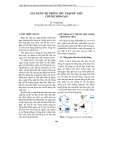
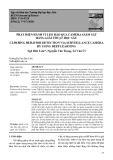
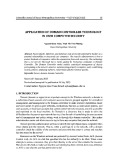
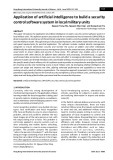
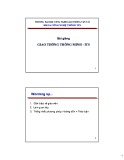




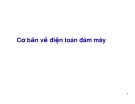


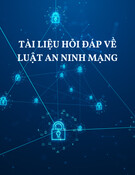
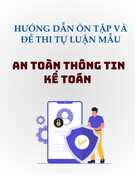
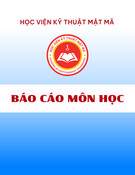
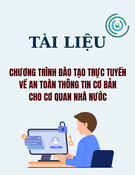
![Sổ tay Kỹ năng nhận diện & phòng chống lừa đảo trực tuyến [Mới nhất]](https://cdn.tailieu.vn/images/document/thumbnail/2025/20251017/kimphuong1001/135x160/8271760665726.jpg)
![Cẩm nang An toàn trực tuyến [Mới nhất]](https://cdn.tailieu.vn/images/document/thumbnail/2025/20251017/kimphuong1001/135x160/8031760666413.jpg)


